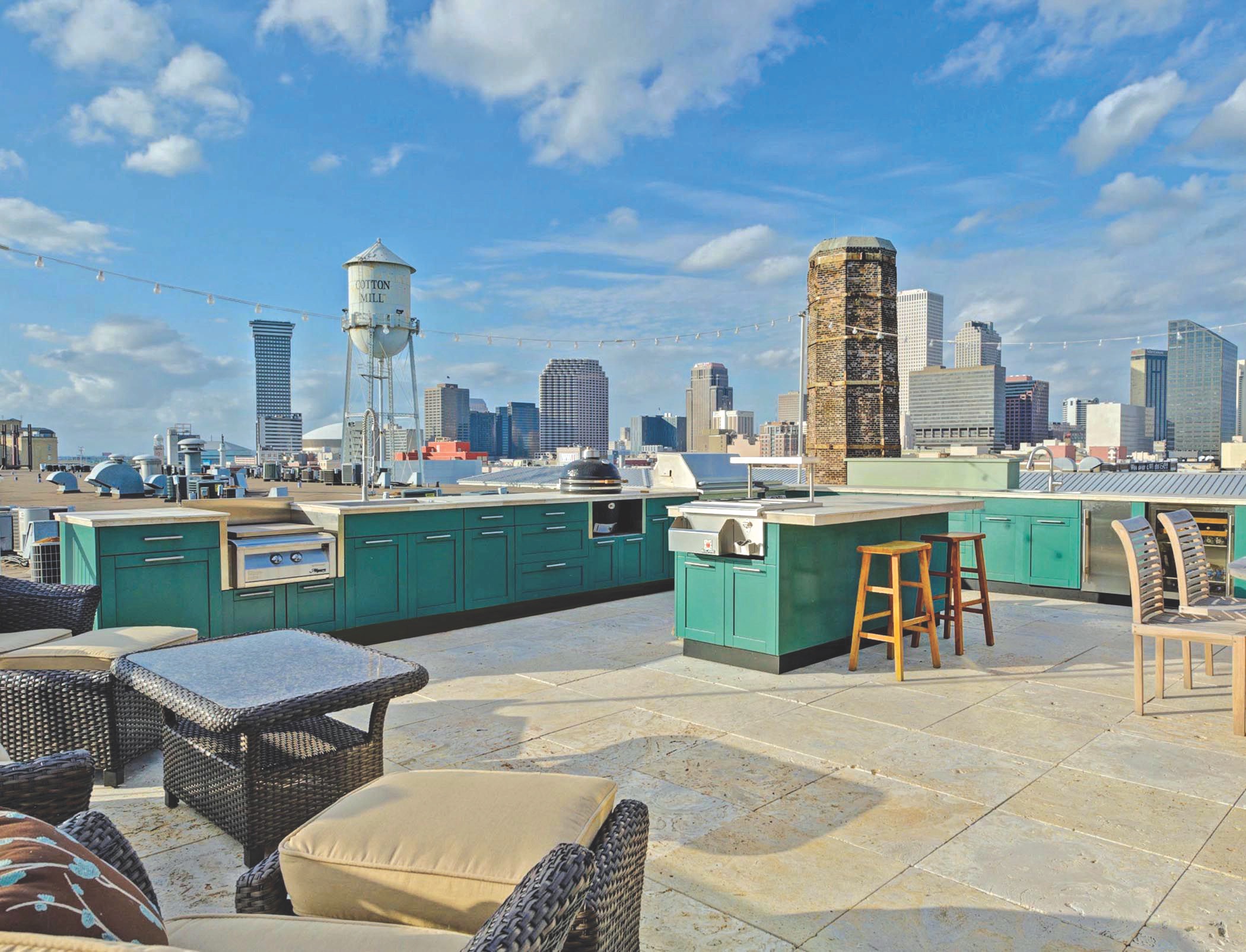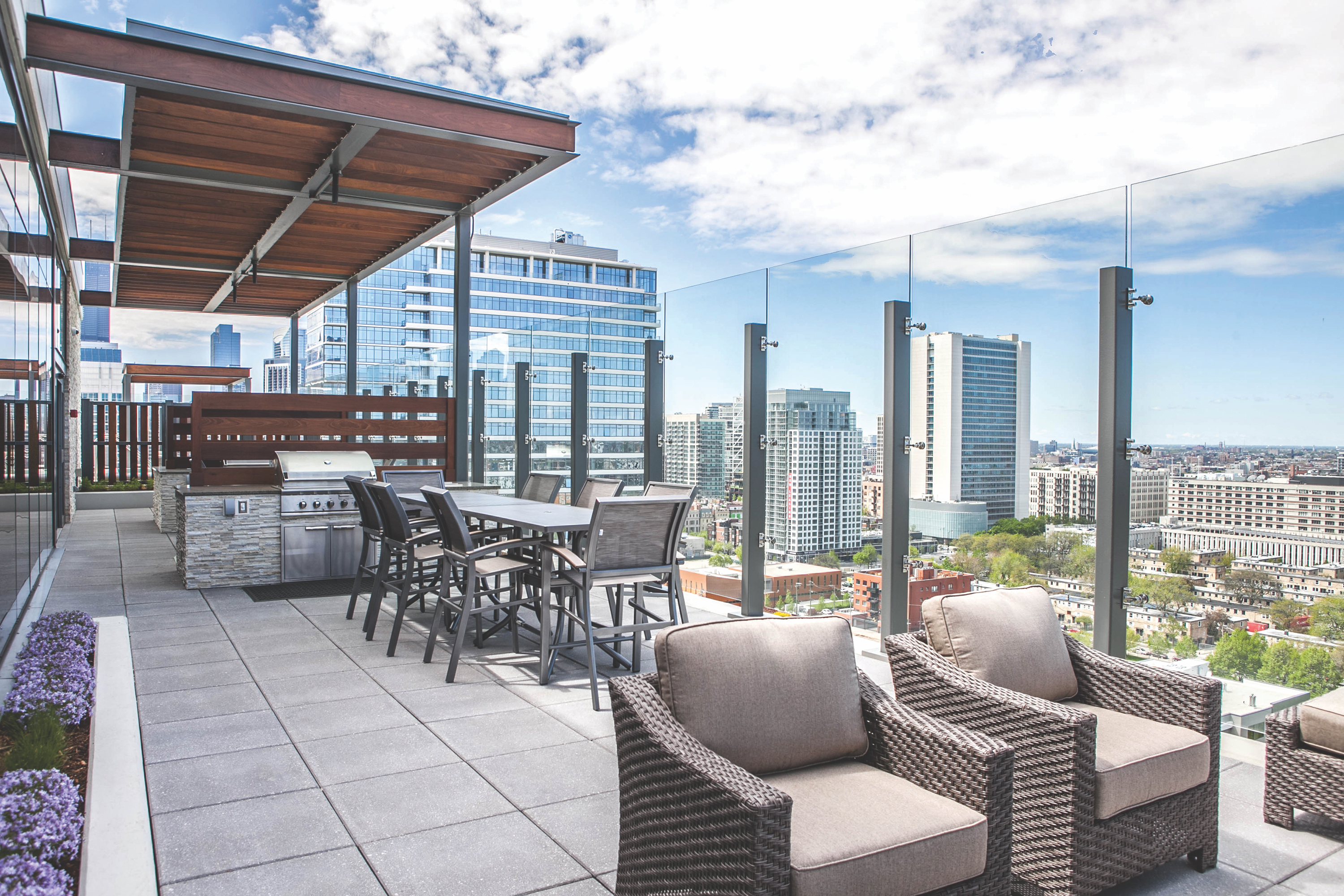A growing appetite for outdoor living spaces is fueling an expansion of outdoor kitchens on roof decks, terraces, and courtyards.
“In the last few years, we’ve seen an enormous increase in demand as high-end rental properties, condos, and townhomes take advantage of the indoor-outdoor living phenomenon,” said Mitch Slater, Founder/President, Danver Stainless Outdoor Kitchens (danver.com).
The design of these open-air amenity spaces has evolved from standalone grill stations to sophisticated meal preparation and dining environments that emphasize convenience and community. “These days, the goal is to get people to stay outside longer and have a great experience,” said Kristen Larkin, ASID, Associate Principal, FitzGerald Associates Architects, Chicago.
Although there’s no standard template for outdoor kitchens, designers and manufacturers we spoke with shared practical advice for ensuring these amenity spaces deliver safe, memorable experiences for residents and guests.
1. Design a simple, logical layout. L-shape, U-shape, and island layouts are common configurations for outdoor kitchens. Marieke Lacasse, ASLA, LEED AP BD+C, Principal at Seattle-based design firm GGLO, recommends locating them close to the pool area or party room to create a social hub and event space. “Outdoor kitchens are places to congregate around food, so it’s important to provide adequate food prep areas, sink space, and support surfaces,” she said.
‘Outdoor living is here to stay, so not having an outdoor kitchen really devalues your asset.’
—Marieke Lacasse, GGLO
Larkin likes to engage the management company that will maintain the space early in the design process, to ensure everyone’s goals are aligned. “I want to make sure any decisions I make on their behalf are in the long-term interests of the building owner,” she said.
2. Provide indoor-outdoor continuity. The growing popularity of sliding glass walls opens the door for outdoor kitchens to function as extensions of the interior environment. “Interior designers need to work closely with landscape architects to achieve design continuity between these areas,” said Jason Valentin, Associate IIDA, Interior Design Coordinator at Stantec.
Team collaboration extends to design details. “Don’t just think programmatically about how the spaces work together, but think also about the overall language of materiality such as patterns, colors, and metals,” said Lacasse. “Every little detail needs to be thought through to create a cohesive indoor-outdoor connection.”

Toni Wendel, Owner of Olde World Builders and Remodelers, chose Danver Stainless Outdoor Kitchens cabinetry with green powder-coat finish for this condo building in New Orleans’s historic Warehouse District. Photo: Chad Chenier Photography
3. Select durable, easy-to-maintain materials. “We push for sturdy, stable baseline construction materials,” said Larkin, who favors steel trellises over all-wood structures. She recommends easy-to-maintain surfaces such as stainless steel cabinetry and granite countertops. Powder-coated stainless steel cabinetry offers added protection against moisture damage. Powder coatings can also be colored, opening up design possibilities.
The inevitable spills and splatters from shared grills should be considered when selecting flooring materials. “We’ve learned to use darker pavers in front of barbecue spaces, because grease is more visible on lighter-colored pavers and they stain easily,” said GGLO’s Lacasse.
4. Emphasize safety and accessibility. To protect residents and guests from the potential hazards of open flames and hot surfaces, locate grills, ovens, and fire pit tables in sheltered environments away from high-wind areas—or use a flameless electric grill. All adjacent structures should use fire-resistant building materials, such as fire-treated wood or light-gauge aluminum frame.
Designers also must follow ADA accessibility requirements for kitchens: providing adequate clearance areas and adhering to surface height requirements for sinks, appliances, cabinets, countertops, and food prep areas.
5. Take local climate into consideration. In colder climates sinks, icemakers, and refrigerators that have outdoor plumbing need to be winterized. “If an outdoor sink isn’t feasible, it’s important to consider adjacencies—how far will a resident have to carry a dirty spatula from the grill to an indoor sink to clean it?” said Larkin.
Humid environments and extreme weather events pose their own problems. “In Miami, we need to specify marine-grade materials such as plywood and cement board as a substrate for the millwork and cabinetry,” said Stantec’s Valentin. “We wouldn’t specify a typical laminate that we might use in an interior space.”

Pappageorge Haymes Partners installed this rooftop outdoor kitchen suite at LUXE on Madison (P II), a four-story, 44-unit apartment community in Chicago’s West Loop. Fifield Development is the developer. Photo courtesy Pappageorge Haymes Partners
6. Use lighting to enhance the ambience. Because nighttime is prime time for grilling, effective lighting is essential for maximizing safety and functionality. Our experts recommend using subtle, indirect lighting strategies that meet local outdoor lighting code requirements while maintaining an ambience conducive to a relaxing night under the stars.
Wind can play havoc with decorative lighting fixtures. FitzGerald’s Larkin suggests using softer bounce lights and integrating the lighting into a trellis or overhead structure to make the space feel more intimate.
7. Offer cooking options. Multifamily developers are expanding their cooking repertoire to include electric cooktops, smokers, and pizza ovens. Manufacturers like Danver offer commercial-grade bartending stations and mobile F&B service carts.
Properties with space or budget constraints can still raise their game. Thor Kitchen (thorkitchen.com) offers a compact modular outdoor kitchen suite that has a gas grill, side burner, wood-burning pizza oven, refrigerator drawers, grill cabinet, sink cabinet, corner cabinet, and appliance cabinet. Danver’s Post and Panel System employs powder-coated stainless steel panels that ship flat and can be installed in the cabinetry even with the countertop in place.
Do outdoor kitchens enhance a property’s marketability? Yes, said GGLO’s Lacasse. “All the best properties have them,” she noted. “The outdoor living trend is definitely here to stay, so not having an outdoor kitchen really devalues your asset.”
Related Stories
| Oct 13, 2010
Apartment complex will offer affordable green housing
Urban Housing Communities, KTGY Group, and the City of Big Bear Lake (Calif.) Improvement Agency are collaborating on The Crossings at Big Bear Lake, the first apartment complex in the city to offer residents affordable, eco-friendly homes. KTGY designed 28 two-bedroom, two-story townhomes and 14 three-bedroom, single-story flats, averaging 1,100 sf each.
| Oct 13, 2010
Residences bring students, faculty together in the Middle East
A new residence complex is in design for United Arab Emirates University in Al Ain, UAE, near Abu Dhabi. Plans for the 120-acre mixed-use development include 710 clustered townhomes and apartments for students and faculty and common areas for community activities.
| Oct 13, 2010
Community center under way in NYC seeks LEED Platinum
A curving, 550-foot-long glass arcade dubbed the “Wall of Light” is the standout architectural and sustainable feature of the Battery Park City Community Center, a 60,000-sf complex located in a two-tower residential Lower Manhattan complex. Hanrahan Meyers Architects designed the glass arcade to act as a passive energy system, bringing natural light into all interior spaces.
| Oct 12, 2010
The Watch Factory, Waltham, Mass.
27th Annual Reconstruction Awards — Gold Award. When the Boston Watch Company opened its factory in 1854 on the banks of the Charles River in Waltham, Mass., the area was far enough away from the dust, dirt, and grime of Boston to safely assemble delicate watch parts.
| Sep 13, 2010
Richmond living/learning complex targets LEED Silver
The 162,000-sf living/learning complex includes a residence hall with 122 units for 459 students with a study center on the ground level and communal and study spaces on each of the residential levels. The project is targeting LEED Silver.
| Sep 13, 2010
Committed to the Core
How a forward-looking city government, a growth-minded university, a developer with vision, and a determined Building Team are breathing life into downtown Phoenix.
| Aug 11, 2010
Brown Craig Turner opens senior living studio
Baltimore-based architecture and design firm Brown Craig Turner has significantly expanded its housing design capabilities and expertise with the launch of its new senior living studio.
| Aug 11, 2010
CTBUH changes height criteria; Burj Dubai height increases, others decrease
The Council on Tall Buildings and Urban Habitat (CTBUH)—the international body that arbitrates on tall building height and determines the title of “The World’s Tallest Building”—has announced a change to its height criteria, as a reflection of recent developments with several super-tall buildings.
| Aug 11, 2010
Morphosis builds 'floating' house for Brad Pitt's Make It Right New Orleans foundation
Morphosis Architects, under the direction of renowned architect and UCLA professor Thom Mayne, has completed the first floating house permitted in the U.S. for Brad Pitt’s Make It Right Foundation in New Orleans.The FLOAT House is a new model for flood-safe, affordable, and sustainable housing that is designed to float securely with rising water levels.













